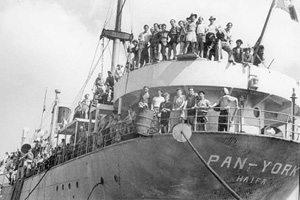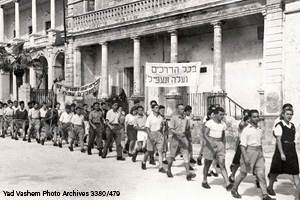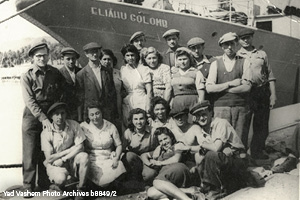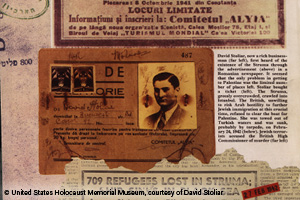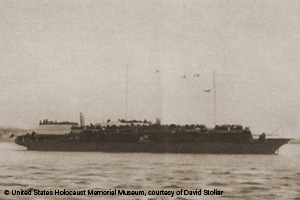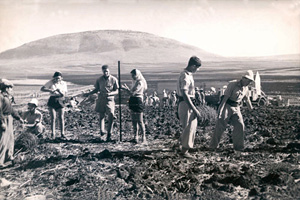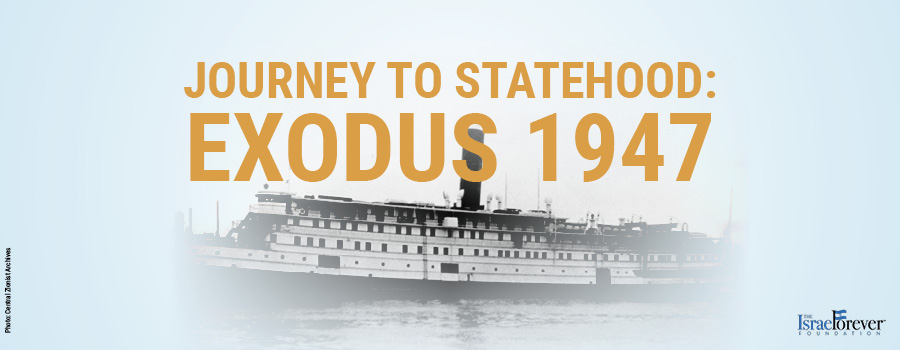ALIYAH BET
The ships that rescued over 100,000 Jews during and after World War II
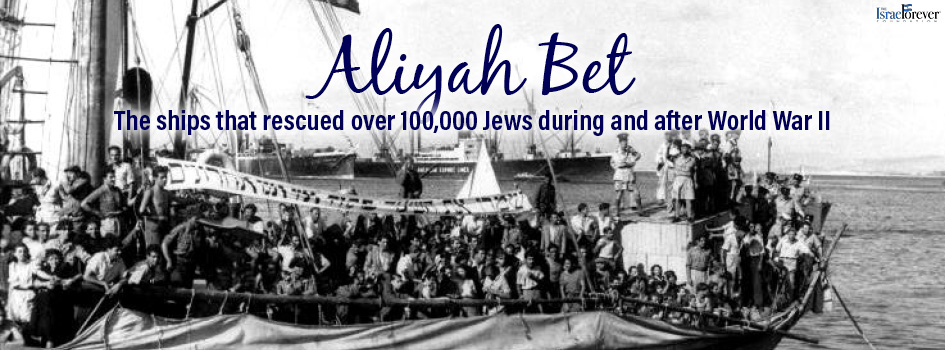
Following the historic Balfour Declaration, Great Britain was publicly committed to the establishment a Jewish state in Palestine. However, the British authorities were strongly affected by Arab pressure and began withdrawing their support for Jewish nationalism in spite of its transition into international law at the San Remo Conference and the League of Nations in 1924.
By the early 1930s the British had imposed severe quotas on Jewish immigration, and Zionist groups responded with a renewal of the efforts to bring Jews to Palestine through Aliyah Bet, meaning the second round of movement “up” to the holy land of Eretz Yisrael. The word Aliyah in Hebrew means ascent, which has the idealistic connotation of returning to the ancient Jewish homeland, reflected by the Zionist ideals and efforts. The First and Second Aliyot of 1882 - 1903 and 1903 – 1914 had achieved great strides in their settlement of the homeland, inspired by the Zionism of the Chovevei Tzion (Lovers of Zion) movement, and the outgrowth of the Zionist movement in general.
There was, at the time, very limited Jewish immigration permitted by the British - known as Aliyah Aleph. But the situation in Europe and in Mandate Palestine called for a more comprehensive effort to save the remnants of Europe’s Jews from the hands of the Nazis. The Mossad l’Aliyah Bet ( עלייה ב- shortened from Aliya Bilty Legalit עלייה בלתי-לגאלית ) - was established by the Haganah, Jewish defense forces in the Yishuv and Aliyah Bet became the codename given to illegal immigration Jews to Mandatory Palestine between 1934 and 1948, most of whom were Holocaust survivors and refugees from Nazi Germany. The name Ha'apala is also a modern interpretation of the verb va'ya'apilu which appears only once in the Bible, in Numbers 14:44, "But they presumed to go up unto the hill top".
The Jewish Agency leadership did not approve of illegal methods of immigration but, by 1939, David Ben-Gurion realized that Aliya Bet was the only real option for Jews to reach Palestine. The movement was officially referred to as Ha'apala, הַעְפָּלָה, meaning upward struggle, and the immigrants ma'apilim מעפילים. Most reached Palestine by boat and tried to enter the country secretly, in direct defiance of the British government's restriction on Jewish immigration. Emissaries from the yishuv, Jewish partisans and Zionist youth movements worked together to enable the Beriha (בריחה - escape) which transformed into a collaborative recognized organization which helped nearly 200,000 Jews leave Europe. The Palyam, a marine branch of the Palmach, was given responsibility for commanding and sailing ships.
Aliya Bet became one of the principle ways of rescuing Jews during World War II, and the first ship of illegal immigrants reached Palestine in 1934. Every effort, every ship, faced a myriad of obstacles, including the restriction of ship use, lack of funds, the continuing British blockade of Palestine, and unsafe conditions. All of these problems forced the slowing down of operations , by 1942. The Mossad resumed their efforts in 1944 when the "Final Solution” became known to the Jews of Palestine and sought to do everything they could to save those who could be saved.
In total, it is estimated that between 1939 and 1948 approximately 110,000 Jewish immigrants had participated in Aliyah Bet by sailing to the territory of the British Mandate. Overland, about 9,000 Jews, including 1,350 Syrian Jews were escorted to Palestine in intricate and audacious operations. The number of immigrants during the entire mandate period, legal and illegal alike, was approximately 480,000, close to 90% of them from Europe. The population of the Yishuv expanded to 650,000 by the time statehood was proclaimed.
After the war, Aliya Bet became the crux of Zionist activity, focusing the world's attention on the plight of those Holocaust survivors who wanted to immigrate to a Jewish state. Tens of thousands of would-be immigrants arrived at the shores of Palestine on dozens of ships (among them the Exodus 1947), only to be caught by the British and interned in detention camps. About half were held in Cyprus until the State of Israel was established in May 1948.
THE SHIPS OF THE ALIYAH BET
- The Josiah Wedgewood (originally the Beauhamois), a Canadian corvette.
- The Hagana (originally the Norsyd), also a Canadian corvette.
- The Haim Arlosoroff (originally the Ulua), a coast guard cutter from the 1920s.
- The Ben Hecht (originally the Abril) had been a private yacht, a smuggler’s boat and a coast guard vessel.
- The Hatikva (originally the Tradewinds 1908) a coast guard cutter.
- The Exodus 1947 (originally the President Warfield), a Chesapeake Bay excursion ferry.
- The Geula (originally the Paducah, )a coast guard training vessel.
- The Jewish State (originally the Northland), a coast guard icebreaker.
- The Kibbutz Galuyot (originally the Pan York), a cargo vessel.
- The Atzmaut (originally the Pan Crescent), also a cargo vessel.
LEARN MORE »

